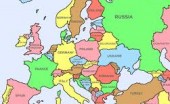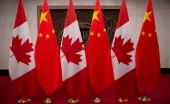Johannah Bernstein post: "eternally proud of my father’s extraordinary aeronautical engineering. legacy. here is a photo of the Canadair Water…
Asian Development Outlook
Written by Diana Thebaud Nicholson // April 13, 2015 // Asia // Comments Off on Asian Development Outlook
Asian Development Outlook 2015: Financing Asia’s Future Growth
ADB’s Asian Development Outlook (ADO) 2015 projects that Developing Asia will grow at a steady 6.3% in 2015 and 2016, supported by a strengthening recovery in the major industrial economies and soft global commodity prices.
Joseph Stiglitz: Asia’s Multilateralism
(Project Syndicate) The $50 billion AIIB, launched by China, will help meet Asia’s enormous infrastructure needs, which are well beyond the capacity of today’s institutional arrangements to finance.
One would have thought that the AIIB’s launch, and the decision of so many governments to support it, would be a cause for universal celebration. And for the IMF, the World Bank, and many others, it was. But, puzzlingly, wealthy European countries’ decision to join provoked the ire of American officials. Indeed, one unnamed American source accused the UK of “constant accommodation” of China. Covertly, the United States put pressure on countries around the world to stay away.
In fact, America’s opposition to the AIIB is inconsistent with its stated economic priorities in Asia. Sadly, it seems to be another case of America’s insecurity about its global influence trumping its idealistic rhetoric – this time possibly undermining an important opportunity to strengthen Asia’s developing economies.
6 April
Kenneth Rogoff asks Will China’s Infrastructure Bank Work?
(Project Syndicate) “Far too little attention has been devoted to understanding why multilateral development lending has so often failed, and what might be done to make it work better. Multilateral development institutions have probably had their most consistent success when they serve as “knowledge” banks, helping to share experience, best practices, and technical knowledge across regions. By contrast, their greatest failures have come from funding grandiose projects that benefit the current elite, but do not properly balance environmental, social, and development priorities.” … “We should evaluate the AIIB by how it chooses and fosters projects, not just by how much financing it provides.”
24 March
The Bright Future of Asia’s Middle Class
Lee Jong-Wha, Professor of Economics and Director of the Asiatic Research Institute at Korea University
(World Post) Despite recent economic uncertainty, Asia’s middle class is growing fast. In the coming decades, this burgeoning demographic segment will serve as a keystone for economic and political development in the region, with significant implications for the rest of the world.
The OECD estimates that the global middle class (defined as households with daily expenditures of $10-100 per person, in 2005 purchasing power parity terms) will swell to 4.9 billion people by 2030, from 1.8 billion in 2009. Two-thirds are expected to reside in Asia, up from 28 percent in 2009, with China home to the largest share. Indeed, if China pursues the structural reforms and technological upgrading needed to maintain rapid economic growth, its middle class should exceed one billion people in 2030, up from 157 million in 2009.
The rapid emergence of Asia’s middle class will bring far-reaching economic change, creating new market opportunities for domestic and international companies. Already, demand for consumer durables has increased in the region, with China becoming the world’s largest market for automobiles and mobile phones. But there remains substantial room for more consumption in luxury goods and technological products, as the purchasing power of the developing world’s middle class catches up to that in the advanced countries.
This convergence will contribute to more sustainable economic growth, with Asia’s economies rebalancing toward domestic demand, especially household consumption, and thereby becoming less vulnerable to external shocks.
17 March
Jim O’Neill: Making Space for China
(Project Syndicate) When the United Kingdom announced earlier this month that it had agreed to become a founding member of the China-led Asian Infrastructure Investment Bank (AIIB), most of the headlines focused not on the news itself, but on the friction the decision had caused between the UK and the United States. … America’s reluctance – and that of France, Germany, and Italy – to give the emerging powers an appropriate voice in the established international financial institutions is counterproductive. It drives the creation of new parallel institutions such as the AIIB and the New Development Bank, founded in 2014 by the BRICS countries (Brazil, Russia, India, China, and South Africa). In the coming days, I will be visiting China in my role as Chair of the British government’s Review on Antimicrobial Resistance, and also as a participant in the Boao Forum for Asia, an event similar to the annual gathering of the World Economic Forum in Davos. I hope to encourage Chinese policymakers to make the fight against antimicrobial resistance a priority when China chairs the G-20 in 2016.
2014
5 November
Three major nations absent as China launches World Bank rival in Asia
(Reuters) – Australia, Indonesia and South Korea skipped the launch of a China-backed Asian infrastructure bank on Friday as the United States said it had concerns about the new rival to Western-dominated multilateral lenders.
China’s proposed $50 billion Asian Infrastructure Investment Bank (AIIB) is seen as a challenge to the World Bank and Asian Development Bank, both multilateral lenders that count Washington and its allies as their biggest financial backers.
China, which is keen to extend its influence in the region, has limited voting power over these existing banks despite being the world’s second-largest economy.
The AIIB, launched in Beijing at a ceremony attended by Chinese finance minister Lou Jiwei and delegates from 21 countries including India, Thailand and Malaysia, aims to give project loans to developing nations. China is set to be its largest shareholder with a stake of up to 50 percent.
July
Asian Development Outlook 2014 Supplement: Stable Growth Outlook for Developing Asia
Developing Asia’s outlook remains on track despite slower-than-expected first quarter growth in the United States. The region is projected to grow steadily at 6.2% in 2014 and 6.4% in 2015, the same rates envisaged in Asian Development Outlook 2014. Slight downward revisions to GDP forecasts for Central Asia, Southeast Asia, and the Pacific are balanced by upward adjustments for South Asia. Relatively stable oil prices and declining food prices are helping to keep inflation in check such that consumer prices in the region are now expected to rise more slowly in 2014 than previously projected.
Growth in Southeast Asia softened in the first half of 2014 largely because of country-specific factors in Indonesia, Thailand, and Viet Nam. The outlook for the subregion’s five largest economies is revised down to 4.8% in 2014, dragging the subregional forecast to 4.7%, but should rebound in 2015 to 5.6%, or 5.4% across Southeast Asia.
April
Asian Development Outlook 2014: Fiscal Policy for Inclusive Growth
ADB’s Asian Development Outlook (ADO) 2014 projects that developing Asia’s growth will increase from 6.1% in 2013 to 6.2% in 2014 and 6.4% in 2015.
Developing Asia is expected to extend its steady growth. … Moderating growth in the People’s Republic of China (PRC) as its economy adjusts to more balanced growth will offset to some extent the stronger demand expected from the industrial countries as their economies recover.
Risks to the outlook have eased and are manageable. The monetary policy shift in the United States (US) may invite some volatility ahead in financial markets, albeit mitigated by accommodative monetary policy in Japan and the euro area. The regional growth outlook depends on continued recovery in the major industrial economies and on the PRC managing to contain internal credit growth smoothly.
Widening income gaps in developing Asia strengthens the case for greater use of fiscal policy to foster equality of opportunity. While the region has benefited from fiscal prudence in the past, demographic and environmental challenges are expected to compete for public resources in the coming years. To boost public spending on equity-enhancing programs such as education and health without undermining fiscal sustainability, the authorities will need to explore a wide range of options for mobilizing revenue and to build equity objectives into their fiscal plans.
2013
ADB’s Asian Development Outlook (ADO) 2013 estimates that regional economic growth in the Asia Pacific region will pick up to 6.6% in 2013 and reach 6.7% in 2014. This is a distinct improvement on 2012, when growth stood at just over 6%. Consumer prices are expected to rise by 4.0% in 2013 and 4.2% in 2014, up from 3.7% last year.
Leading regional economies are settling into a pattern of more moderate, more sustainable growth, founded on new opportunities nearer to home, including domestic consumption and intra-regional trade. Meanwhile, Asia’s contributions to global imbalances—its persistent current account surpluses—are smoothly winding down. Yet, developing Asia’s recovery phase remains vulnerable to shocks. Strong capital inflows could feed asset bubbles, for example.
Asia’s energy challenge
ADO 2013 features a special chapter on Asia’s energy challenges. The region needs an ample supply of clean, affordable energy to continue its rapid growth in the coming decades. To achieve energy security, developing Asia must actively contain its rising demand, aggressively explore new supply sources and technology, and progressively integrate regional energy markets and infrastructure.
Key messages
ADO 2013 key messages include the following:
- Developing Asia’s gross domestic product is forecast to expand by 6.6% in 2013 and 6.7% in 2014, following the slower 6.1% pace in 2012;
- Growth will rebound in the People’s Republic of China, from 7.8% in 2012 to 8.2% in 2013 and 8.0% in 2014, driven by strong consumption and investment;
- India’s growth has the potential to pick up from 5.0% in 2012 to 6.0% in 2013 and 6.5% in 2014, but the South Asian giant must create a more favorable environment for investment if it is to sustain this higher rate;
- Southeast Asia is benefiting from robust domestic demand and greater trade with its neighbors in the region;
- Continued sluggishness in the United States, euro area, and Japan suggests that developing Asia must continue to shift toward more domestic demand and trade with emerging markets;
- Inflation is expected to tick up from 3.7% in 2012 to 4.0% in 2013 and 4.2% in 2014. These pressures remain manageable for now, but will need to be monitored closely, especially as strong capital inflows raise the specter of potential asset market bubbles;
- Developing Asia’s favorable fiscal position cannot be taken for granted, as longer-term structural issues need to be addressed to ensure inclusive growth in the future;
- Political risks are emerging as the main threats to the region’s continued robust growth over the forecast horizon;
- With its rising prominence in the global economy, developing Asia has become a major player in commodity markets;
- Developing Asia’s energy needs will expand in tandem with its growing economic influence, but its own endowment is insufficient;
- Expanding renewable energy sources will not be enough to meet future demand. Consequently, Asia needs to invest in making conventional power cleaner and more efficient; and
- Asia must aspire to the degree of regional cooperation and integration in energy by 2030 that currently prevails in Europe.
Individual country reports may be downloaded.




